Exploring the Positive Impacts of Globalisation on Business Functions
VerifiedAdded on 2020/10/05
|29
|5051
|191
AI Summary
The research explores the multifaceted impacts of globalisation on businesses, emphasizing its positive contributions to organisational efficiency. It delves into how globalisation fosters economic opportunities by opening new markets, promoting international trade, and encouraging investment across borders. Culturally, it facilitates a greater exchange of ideas and practices, leading to enriched corporate environments and innovative approaches. Ethically, the project discusses how global standards and increased scrutiny promote responsible business practices worldwide. The study utilizes various academic sources to provide a comprehensive analysis of these dimensions, supporting its claims with data from multinational corporations.

Managing A Successful
Business Project
Business Project
Paraphrase This Document
Need a fresh take? Get an instant paraphrase of this document with our AI Paraphraser
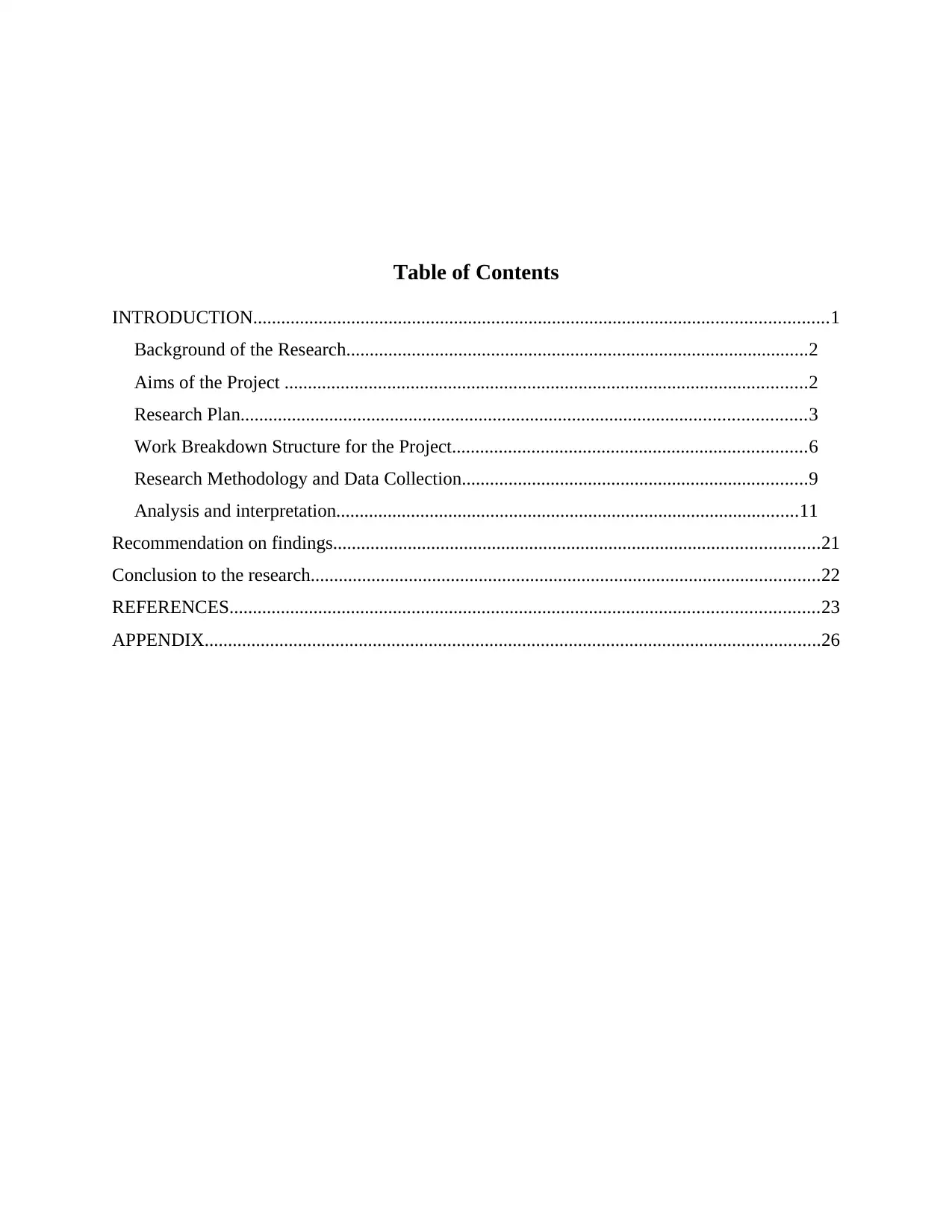
Table of Contents
INTRODUCTION...........................................................................................................................1
Background of the Research...................................................................................................2
Aims of the Project ................................................................................................................2
Research Plan.........................................................................................................................3
Work Breakdown Structure for the Project............................................................................6
Research Methodology and Data Collection..........................................................................9
Analysis and interpretation...................................................................................................11
Recommendation on findings........................................................................................................21
Conclusion to the research.............................................................................................................22
REFERENCES..............................................................................................................................23
APPENDIX....................................................................................................................................26
INTRODUCTION...........................................................................................................................1
Background of the Research...................................................................................................2
Aims of the Project ................................................................................................................2
Research Plan.........................................................................................................................3
Work Breakdown Structure for the Project............................................................................6
Research Methodology and Data Collection..........................................................................9
Analysis and interpretation...................................................................................................11
Recommendation on findings........................................................................................................21
Conclusion to the research.............................................................................................................22
REFERENCES..............................................................................................................................23
APPENDIX....................................................................................................................................26

⊘ This is a preview!⊘
Do you want full access?
Subscribe today to unlock all pages.

Trusted by 1+ million students worldwide
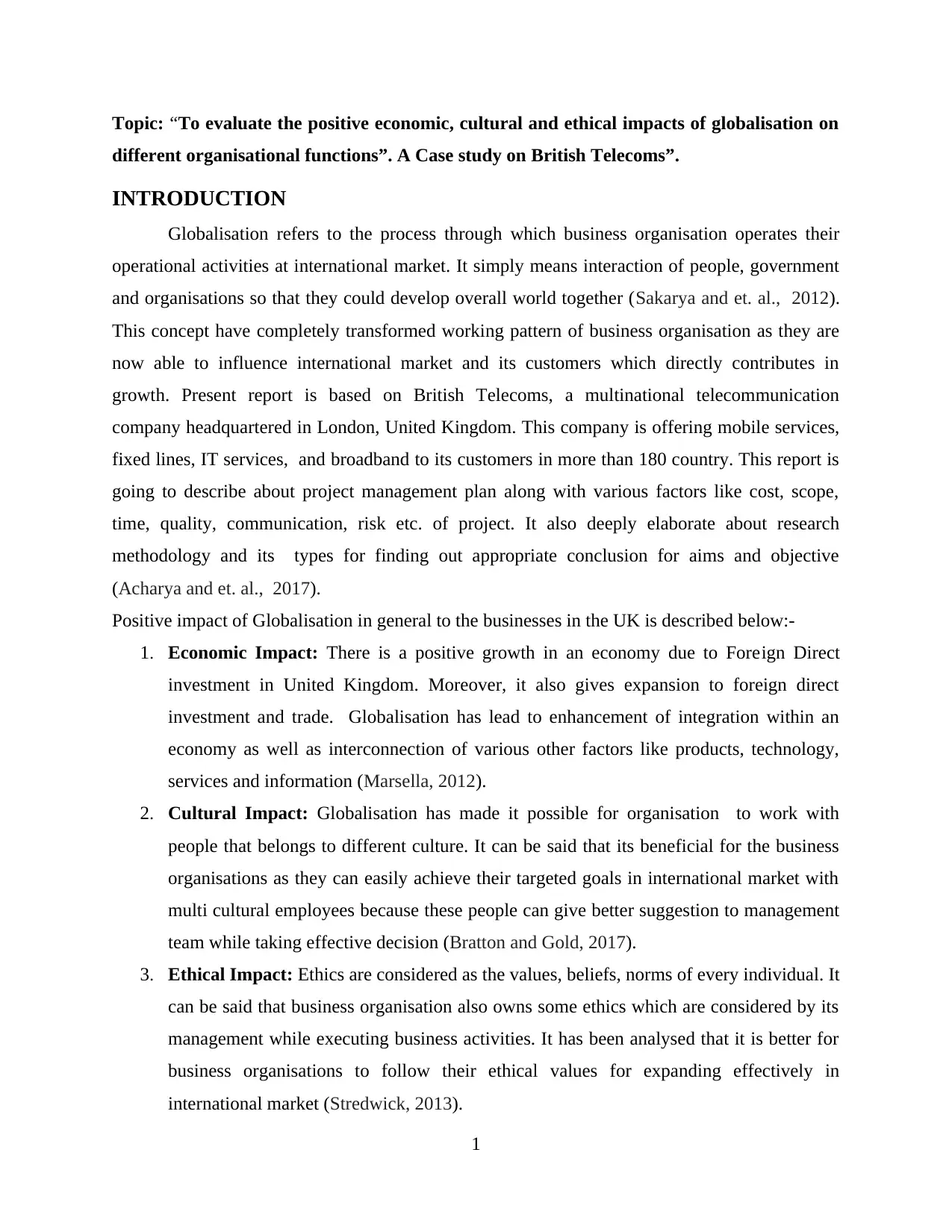
Topic: “To evaluate the positive economic, cultural and ethical impacts of globalisation on
different organisational functions”. A Case study on British Telecoms”.
INTRODUCTION
Globalisation refers to the process through which business organisation operates their
operational activities at international market. It simply means interaction of people, government
and organisations so that they could develop overall world together (Sakarya and et. al., 2012).
This concept have completely transformed working pattern of business organisation as they are
now able to influence international market and its customers which directly contributes in
growth. Present report is based on British Telecoms, a multinational telecommunication
company headquartered in London, United Kingdom. This company is offering mobile services,
fixed lines, IT services, and broadband to its customers in more than 180 country. This report is
going to describe about project management plan along with various factors like cost, scope,
time, quality, communication, risk etc. of project. It also deeply elaborate about research
methodology and its types for finding out appropriate conclusion for aims and objective
(Acharya and et. al., 2017).
Positive impact of Globalisation in general to the businesses in the UK is described below:-
1. Economic Impact: There is a positive growth in an economy due to Foreign Direct
investment in United Kingdom. Moreover, it also gives expansion to foreign direct
investment and trade. Globalisation has lead to enhancement of integration within an
economy as well as interconnection of various other factors like products, technology,
services and information (Marsella, 2012).
2. Cultural Impact: Globalisation has made it possible for organisation to work with
people that belongs to different culture. It can be said that its beneficial for the business
organisations as they can easily achieve their targeted goals in international market with
multi cultural employees because these people can give better suggestion to management
team while taking effective decision (Bratton and Gold, 2017).
3. Ethical Impact: Ethics are considered as the values, beliefs, norms of every individual. It
can be said that business organisation also owns some ethics which are considered by its
management while executing business activities. It has been analysed that it is better for
business organisations to follow their ethical values for expanding effectively in
international market (Stredwick, 2013).
1
different organisational functions”. A Case study on British Telecoms”.
INTRODUCTION
Globalisation refers to the process through which business organisation operates their
operational activities at international market. It simply means interaction of people, government
and organisations so that they could develop overall world together (Sakarya and et. al., 2012).
This concept have completely transformed working pattern of business organisation as they are
now able to influence international market and its customers which directly contributes in
growth. Present report is based on British Telecoms, a multinational telecommunication
company headquartered in London, United Kingdom. This company is offering mobile services,
fixed lines, IT services, and broadband to its customers in more than 180 country. This report is
going to describe about project management plan along with various factors like cost, scope,
time, quality, communication, risk etc. of project. It also deeply elaborate about research
methodology and its types for finding out appropriate conclusion for aims and objective
(Acharya and et. al., 2017).
Positive impact of Globalisation in general to the businesses in the UK is described below:-
1. Economic Impact: There is a positive growth in an economy due to Foreign Direct
investment in United Kingdom. Moreover, it also gives expansion to foreign direct
investment and trade. Globalisation has lead to enhancement of integration within an
economy as well as interconnection of various other factors like products, technology,
services and information (Marsella, 2012).
2. Cultural Impact: Globalisation has made it possible for organisation to work with
people that belongs to different culture. It can be said that its beneficial for the business
organisations as they can easily achieve their targeted goals in international market with
multi cultural employees because these people can give better suggestion to management
team while taking effective decision (Bratton and Gold, 2017).
3. Ethical Impact: Ethics are considered as the values, beliefs, norms of every individual. It
can be said that business organisation also owns some ethics which are considered by its
management while executing business activities. It has been analysed that it is better for
business organisations to follow their ethical values for expanding effectively in
international market (Stredwick, 2013).
1
Paraphrase This Document
Need a fresh take? Get an instant paraphrase of this document with our AI Paraphraser
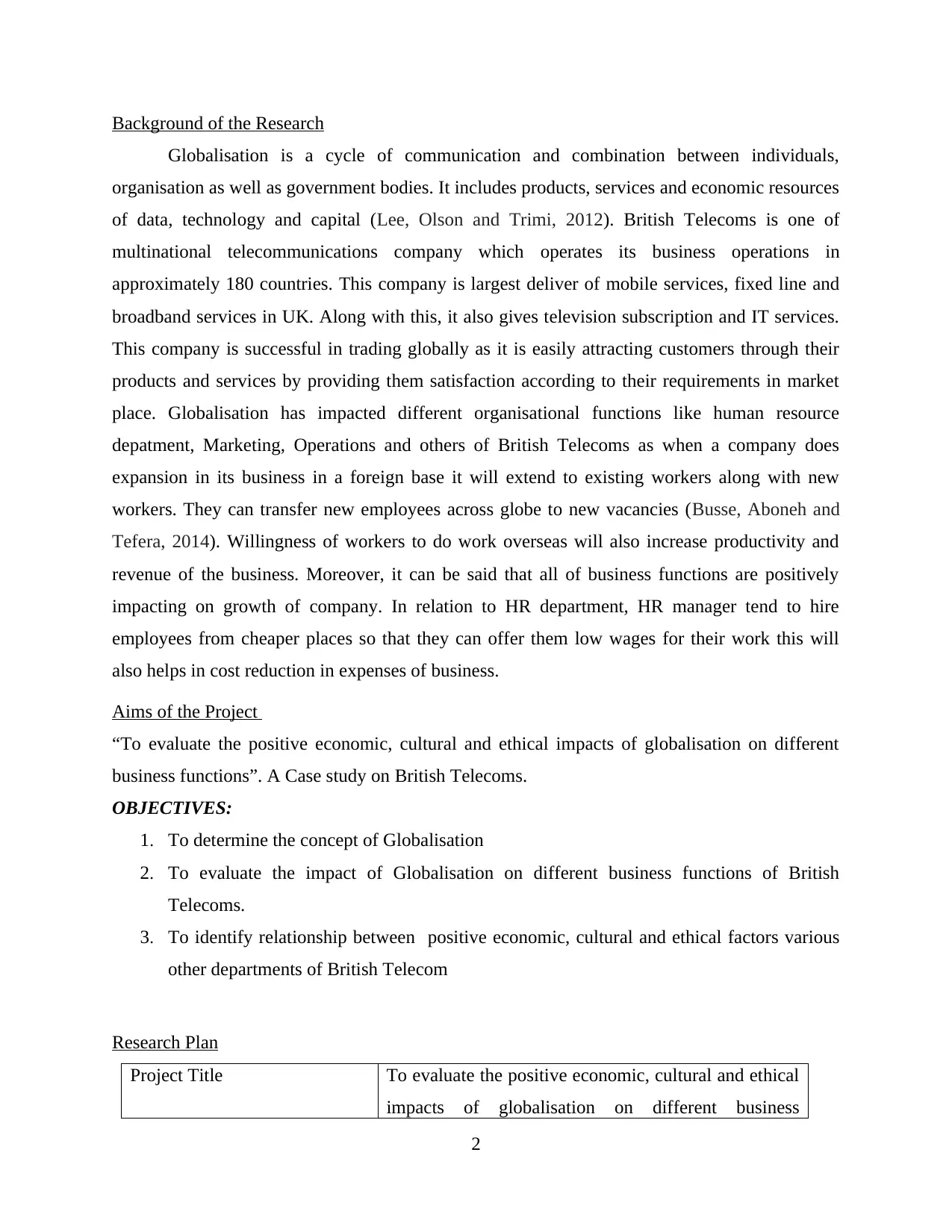
Background of the Research
Globalisation is a cycle of communication and combination between individuals,
organisation as well as government bodies. It includes products, services and economic resources
of data, technology and capital (Lee, Olson and Trimi, 2012). British Telecoms is one of
multinational telecommunications company which operates its business operations in
approximately 180 countries. This company is largest deliver of mobile services, fixed line and
broadband services in UK. Along with this, it also gives television subscription and IT services.
This company is successful in trading globally as it is easily attracting customers through their
products and services by providing them satisfaction according to their requirements in market
place. Globalisation has impacted different organisational functions like human resource
depatment, Marketing, Operations and others of British Telecoms as when a company does
expansion in its business in a foreign base it will extend to existing workers along with new
workers. They can transfer new employees across globe to new vacancies (Busse, Aboneh and
Tefera, 2014). Willingness of workers to do work overseas will also increase productivity and
revenue of the business. Moreover, it can be said that all of business functions are positively
impacting on growth of company. In relation to HR department, HR manager tend to hire
employees from cheaper places so that they can offer them low wages for their work this will
also helps in cost reduction in expenses of business.
Aims of the Project
“To evaluate the positive economic, cultural and ethical impacts of globalisation on different
business functions”. A Case study on British Telecoms.
OBJECTIVES:
1. To determine the concept of Globalisation
2. To evaluate the impact of Globalisation on different business functions of British
Telecoms.
3. To identify relationship between positive economic, cultural and ethical factors various
other departments of British Telecom
Research Plan
Project Title To evaluate the positive economic, cultural and ethical
impacts of globalisation on different business
2
Globalisation is a cycle of communication and combination between individuals,
organisation as well as government bodies. It includes products, services and economic resources
of data, technology and capital (Lee, Olson and Trimi, 2012). British Telecoms is one of
multinational telecommunications company which operates its business operations in
approximately 180 countries. This company is largest deliver of mobile services, fixed line and
broadband services in UK. Along with this, it also gives television subscription and IT services.
This company is successful in trading globally as it is easily attracting customers through their
products and services by providing them satisfaction according to their requirements in market
place. Globalisation has impacted different organisational functions like human resource
depatment, Marketing, Operations and others of British Telecoms as when a company does
expansion in its business in a foreign base it will extend to existing workers along with new
workers. They can transfer new employees across globe to new vacancies (Busse, Aboneh and
Tefera, 2014). Willingness of workers to do work overseas will also increase productivity and
revenue of the business. Moreover, it can be said that all of business functions are positively
impacting on growth of company. In relation to HR department, HR manager tend to hire
employees from cheaper places so that they can offer them low wages for their work this will
also helps in cost reduction in expenses of business.
Aims of the Project
“To evaluate the positive economic, cultural and ethical impacts of globalisation on different
business functions”. A Case study on British Telecoms.
OBJECTIVES:
1. To determine the concept of Globalisation
2. To evaluate the impact of Globalisation on different business functions of British
Telecoms.
3. To identify relationship between positive economic, cultural and ethical factors various
other departments of British Telecom
Research Plan
Project Title To evaluate the positive economic, cultural and ethical
impacts of globalisation on different business
2
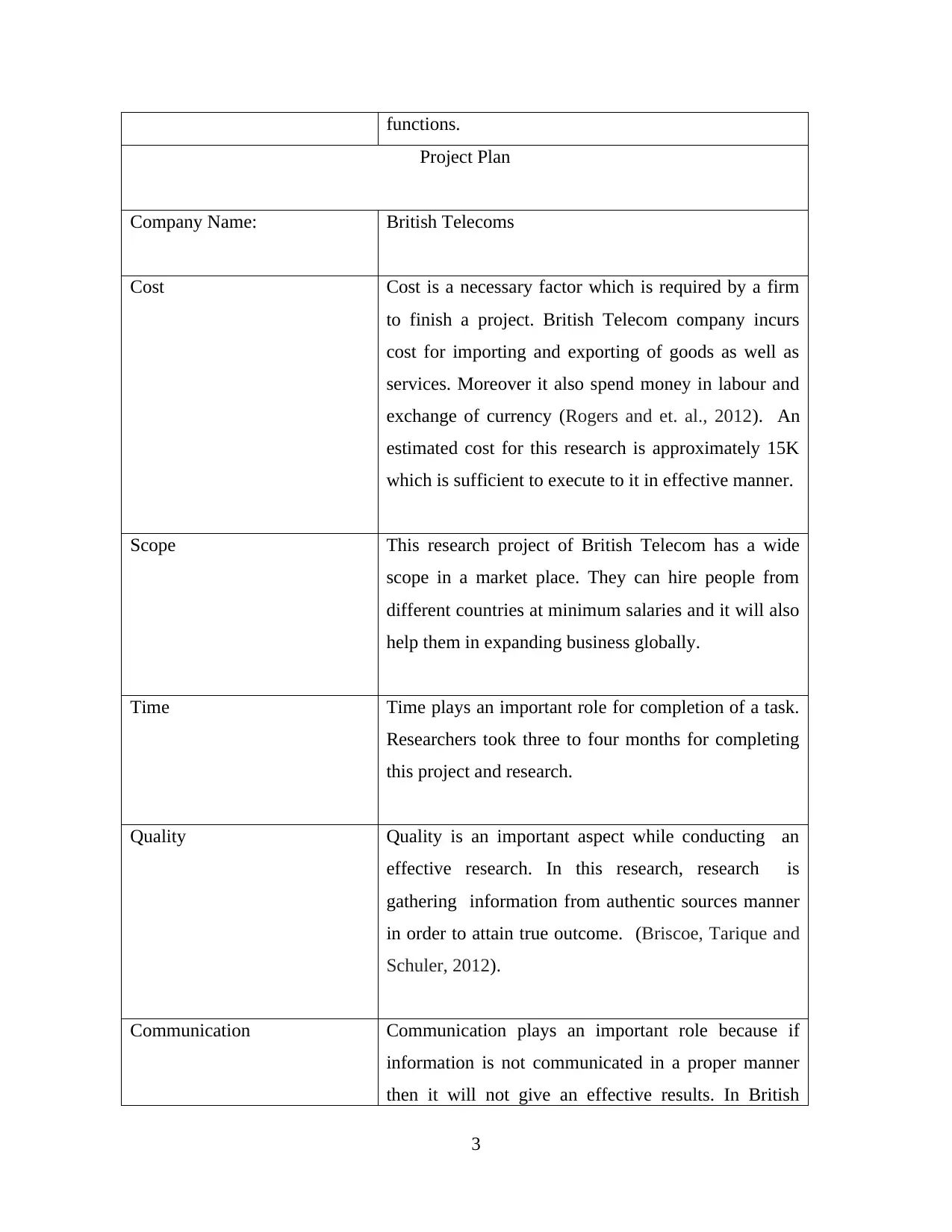
functions.
Project Plan
Company Name: British Telecoms
Cost Cost is a necessary factor which is required by a firm
to finish a project. British Telecom company incurs
cost for importing and exporting of goods as well as
services. Moreover it also spend money in labour and
exchange of currency (Rogers and et. al., 2012). An
estimated cost for this research is approximately 15K
which is sufficient to execute to it in effective manner.
Scope This research project of British Telecom has a wide
scope in a market place. They can hire people from
different countries at minimum salaries and it will also
help them in expanding business globally.
Time Time plays an important role for completion of a task.
Researchers took three to four months for completing
this project and research.
Quality Quality is an important aspect while conducting an
effective research. In this research, research is
gathering information from authentic sources manner
in order to attain true outcome. (Briscoe, Tarique and
Schuler, 2012).
Communication Communication plays an important role because if
information is not communicated in a proper manner
then it will not give an effective results. In British
3
Project Plan
Company Name: British Telecoms
Cost Cost is a necessary factor which is required by a firm
to finish a project. British Telecom company incurs
cost for importing and exporting of goods as well as
services. Moreover it also spend money in labour and
exchange of currency (Rogers and et. al., 2012). An
estimated cost for this research is approximately 15K
which is sufficient to execute to it in effective manner.
Scope This research project of British Telecom has a wide
scope in a market place. They can hire people from
different countries at minimum salaries and it will also
help them in expanding business globally.
Time Time plays an important role for completion of a task.
Researchers took three to four months for completing
this project and research.
Quality Quality is an important aspect while conducting an
effective research. In this research, research is
gathering information from authentic sources manner
in order to attain true outcome. (Briscoe, Tarique and
Schuler, 2012).
Communication Communication plays an important role because if
information is not communicated in a proper manner
then it will not give an effective results. In British
3
⊘ This is a preview!⊘
Do you want full access?
Subscribe today to unlock all pages.

Trusted by 1+ million students worldwide
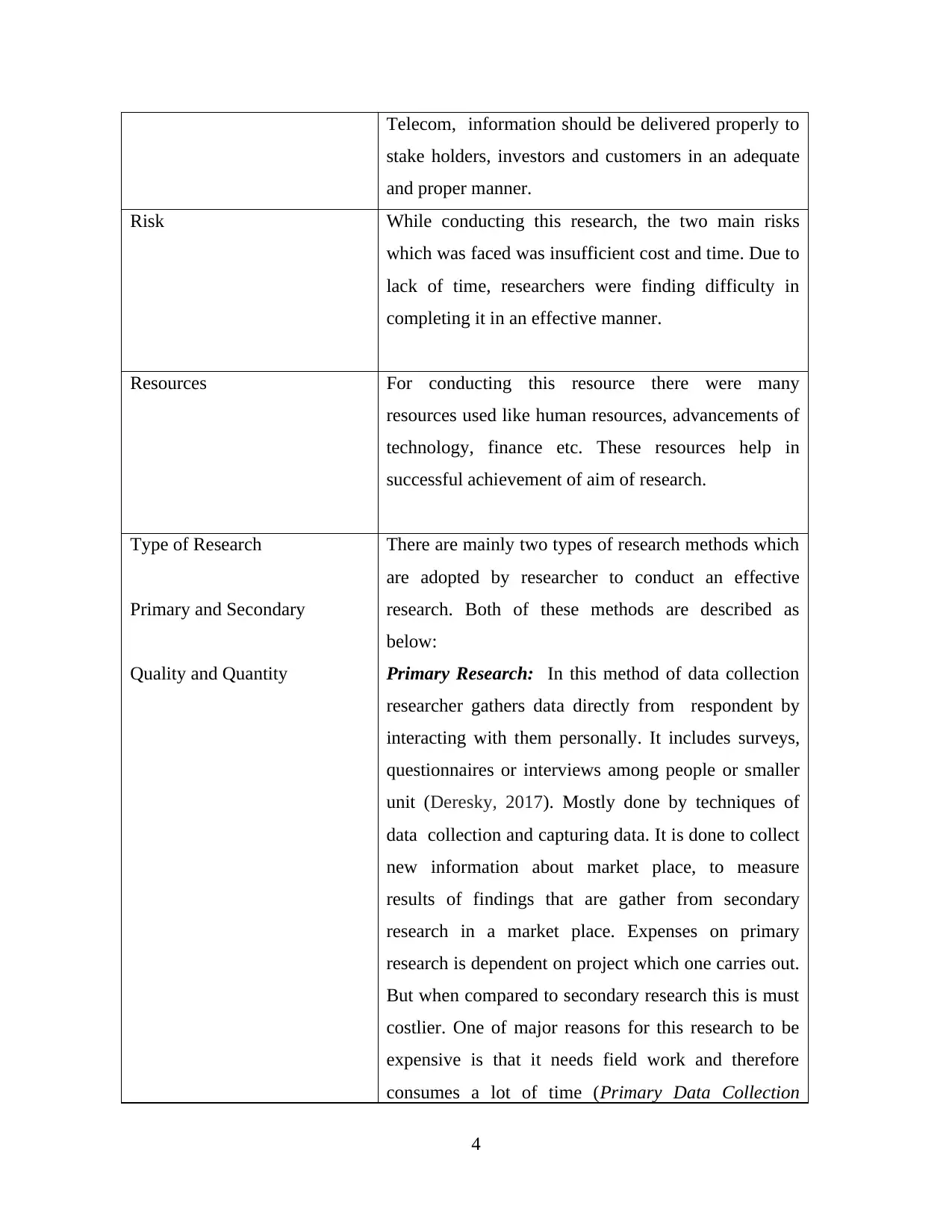
Telecom, information should be delivered properly to
stake holders, investors and customers in an adequate
and proper manner.
Risk While conducting this research, the two main risks
which was faced was insufficient cost and time. Due to
lack of time, researchers were finding difficulty in
completing it in an effective manner.
Resources For conducting this resource there were many
resources used like human resources, advancements of
technology, finance etc. These resources help in
successful achievement of aim of research.
Type of Research
Primary and Secondary
Quality and Quantity
There are mainly two types of research methods which
are adopted by researcher to conduct an effective
research. Both of these methods are described as
below:
Primary Research: In this method of data collection
researcher gathers data directly from respondent by
interacting with them personally. It includes surveys,
questionnaires or interviews among people or smaller
unit (Deresky, 2017). Mostly done by techniques of
data collection and capturing data. It is done to collect
new information about market place, to measure
results of findings that are gather from secondary
research in a market place. Expenses on primary
research is dependent on project which one carries out.
But when compared to secondary research this is must
costlier. One of major reasons for this research to be
expensive is that it needs field work and therefore
consumes a lot of time (Primary Data Collection
4
stake holders, investors and customers in an adequate
and proper manner.
Risk While conducting this research, the two main risks
which was faced was insufficient cost and time. Due to
lack of time, researchers were finding difficulty in
completing it in an effective manner.
Resources For conducting this resource there were many
resources used like human resources, advancements of
technology, finance etc. These resources help in
successful achievement of aim of research.
Type of Research
Primary and Secondary
Quality and Quantity
There are mainly two types of research methods which
are adopted by researcher to conduct an effective
research. Both of these methods are described as
below:
Primary Research: In this method of data collection
researcher gathers data directly from respondent by
interacting with them personally. It includes surveys,
questionnaires or interviews among people or smaller
unit (Deresky, 2017). Mostly done by techniques of
data collection and capturing data. It is done to collect
new information about market place, to measure
results of findings that are gather from secondary
research in a market place. Expenses on primary
research is dependent on project which one carries out.
But when compared to secondary research this is must
costlier. One of major reasons for this research to be
expensive is that it needs field work and therefore
consumes a lot of time (Primary Data Collection
4
Paraphrase This Document
Need a fresh take? Get an instant paraphrase of this document with our AI Paraphraser
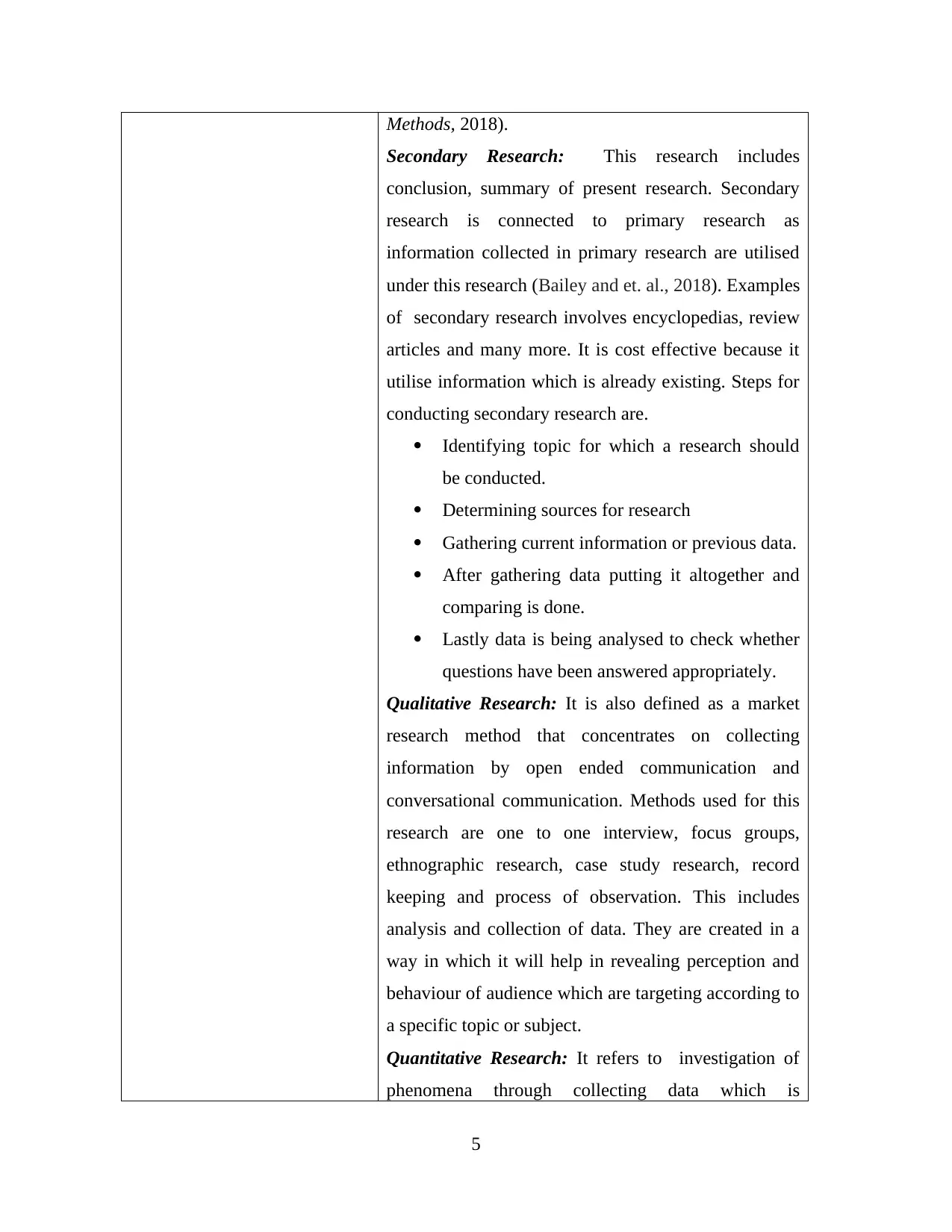
Methods, 2018).
Secondary Research: This research includes
conclusion, summary of present research. Secondary
research is connected to primary research as
information collected in primary research are utilised
under this research (Bailey and et. al., 2018). Examples
of secondary research involves encyclopedias, review
articles and many more. It is cost effective because it
utilise information which is already existing. Steps for
conducting secondary research are.
Identifying topic for which a research should
be conducted.
Determining sources for research
Gathering current information or previous data.
After gathering data putting it altogether and
comparing is done.
Lastly data is being analysed to check whether
questions have been answered appropriately.
Qualitative Research: It is also defined as a market
research method that concentrates on collecting
information by open ended communication and
conversational communication. Methods used for this
research are one to one interview, focus groups,
ethnographic research, case study research, record
keeping and process of observation. This includes
analysis and collection of data. They are created in a
way in which it will help in revealing perception and
behaviour of audience which are targeting according to
a specific topic or subject.
Quantitative Research: It refers to investigation of
phenomena through collecting data which is
5
Secondary Research: This research includes
conclusion, summary of present research. Secondary
research is connected to primary research as
information collected in primary research are utilised
under this research (Bailey and et. al., 2018). Examples
of secondary research involves encyclopedias, review
articles and many more. It is cost effective because it
utilise information which is already existing. Steps for
conducting secondary research are.
Identifying topic for which a research should
be conducted.
Determining sources for research
Gathering current information or previous data.
After gathering data putting it altogether and
comparing is done.
Lastly data is being analysed to check whether
questions have been answered appropriately.
Qualitative Research: It is also defined as a market
research method that concentrates on collecting
information by open ended communication and
conversational communication. Methods used for this
research are one to one interview, focus groups,
ethnographic research, case study research, record
keeping and process of observation. This includes
analysis and collection of data. They are created in a
way in which it will help in revealing perception and
behaviour of audience which are targeting according to
a specific topic or subject.
Quantitative Research: It refers to investigation of
phenomena through collecting data which is
5
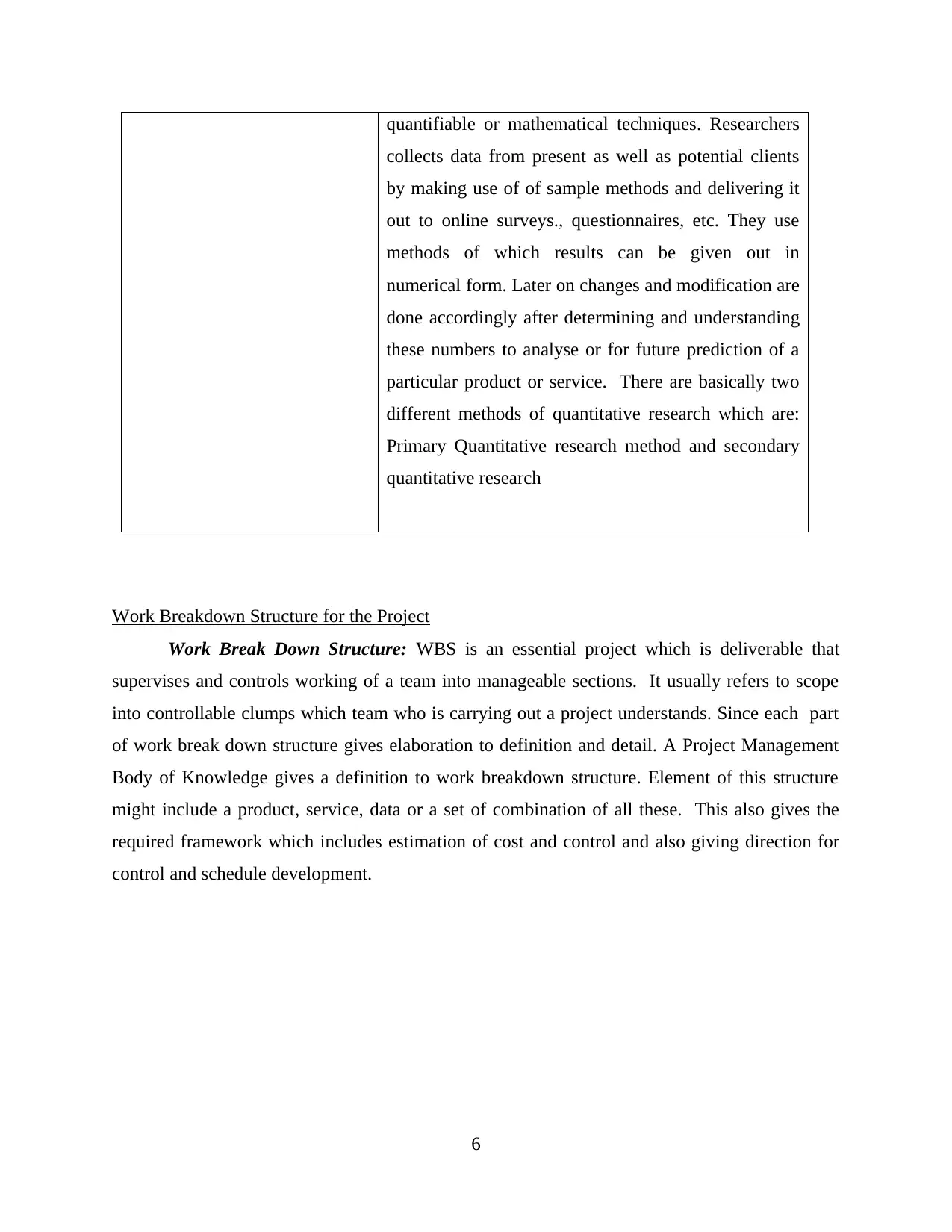
quantifiable or mathematical techniques. Researchers
collects data from present as well as potential clients
by making use of of sample methods and delivering it
out to online surveys., questionnaires, etc. They use
methods of which results can be given out in
numerical form. Later on changes and modification are
done accordingly after determining and understanding
these numbers to analyse or for future prediction of a
particular product or service. There are basically two
different methods of quantitative research which are:
Primary Quantitative research method and secondary
quantitative research
Work Breakdown Structure for the Project
Work Break Down Structure: WBS is an essential project which is deliverable that
supervises and controls working of a team into manageable sections. It usually refers to scope
into controllable clumps which team who is carrying out a project understands. Since each part
of work break down structure gives elaboration to definition and detail. A Project Management
Body of Knowledge gives a definition to work breakdown structure. Element of this structure
might include a product, service, data or a set of combination of all these. This also gives the
required framework which includes estimation of cost and control and also giving direction for
control and schedule development.
6
collects data from present as well as potential clients
by making use of of sample methods and delivering it
out to online surveys., questionnaires, etc. They use
methods of which results can be given out in
numerical form. Later on changes and modification are
done accordingly after determining and understanding
these numbers to analyse or for future prediction of a
particular product or service. There are basically two
different methods of quantitative research which are:
Primary Quantitative research method and secondary
quantitative research
Work Breakdown Structure for the Project
Work Break Down Structure: WBS is an essential project which is deliverable that
supervises and controls working of a team into manageable sections. It usually refers to scope
into controllable clumps which team who is carrying out a project understands. Since each part
of work break down structure gives elaboration to definition and detail. A Project Management
Body of Knowledge gives a definition to work breakdown structure. Element of this structure
might include a product, service, data or a set of combination of all these. This also gives the
required framework which includes estimation of cost and control and also giving direction for
control and schedule development.
6
⊘ This is a preview!⊘
Do you want full access?
Subscribe today to unlock all pages.

Trusted by 1+ million students worldwide
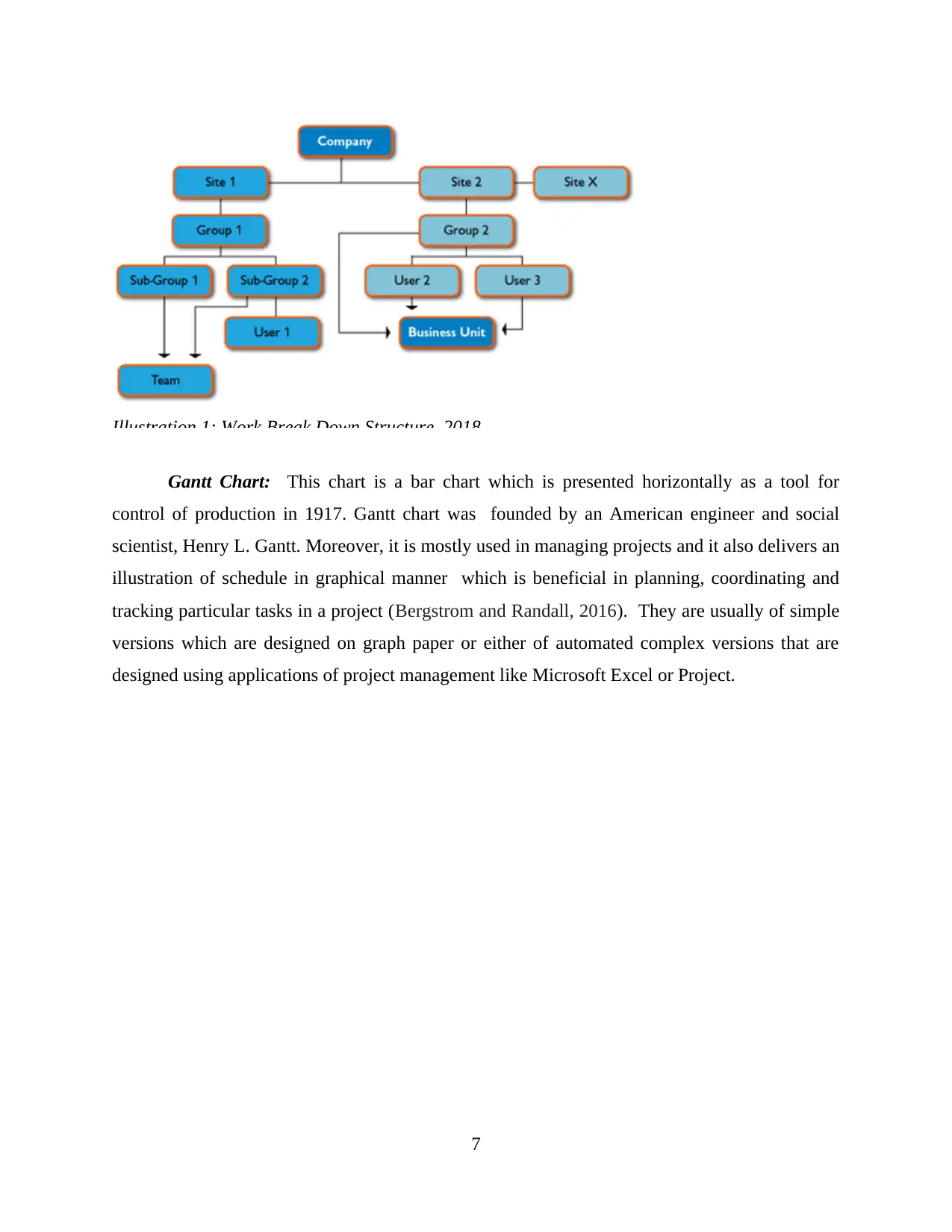
Illustration 1: Work Break Down Structure, 2018
Gantt Chart: This chart is a bar chart which is presented horizontally as a tool for
control of production in 1917. Gantt chart was founded by an American engineer and social
scientist, Henry L. Gantt. Moreover, it is mostly used in managing projects and it also delivers an
illustration of schedule in graphical manner which is beneficial in planning, coordinating and
tracking particular tasks in a project (Bergstrom and Randall, 2016). They are usually of simple
versions which are designed on graph paper or either of automated complex versions that are
designed using applications of project management like Microsoft Excel or Project.
7
Gantt Chart: This chart is a bar chart which is presented horizontally as a tool for
control of production in 1917. Gantt chart was founded by an American engineer and social
scientist, Henry L. Gantt. Moreover, it is mostly used in managing projects and it also delivers an
illustration of schedule in graphical manner which is beneficial in planning, coordinating and
tracking particular tasks in a project (Bergstrom and Randall, 2016). They are usually of simple
versions which are designed on graph paper or either of automated complex versions that are
designed using applications of project management like Microsoft Excel or Project.
7
Paraphrase This Document
Need a fresh take? Get an instant paraphrase of this document with our AI Paraphraser
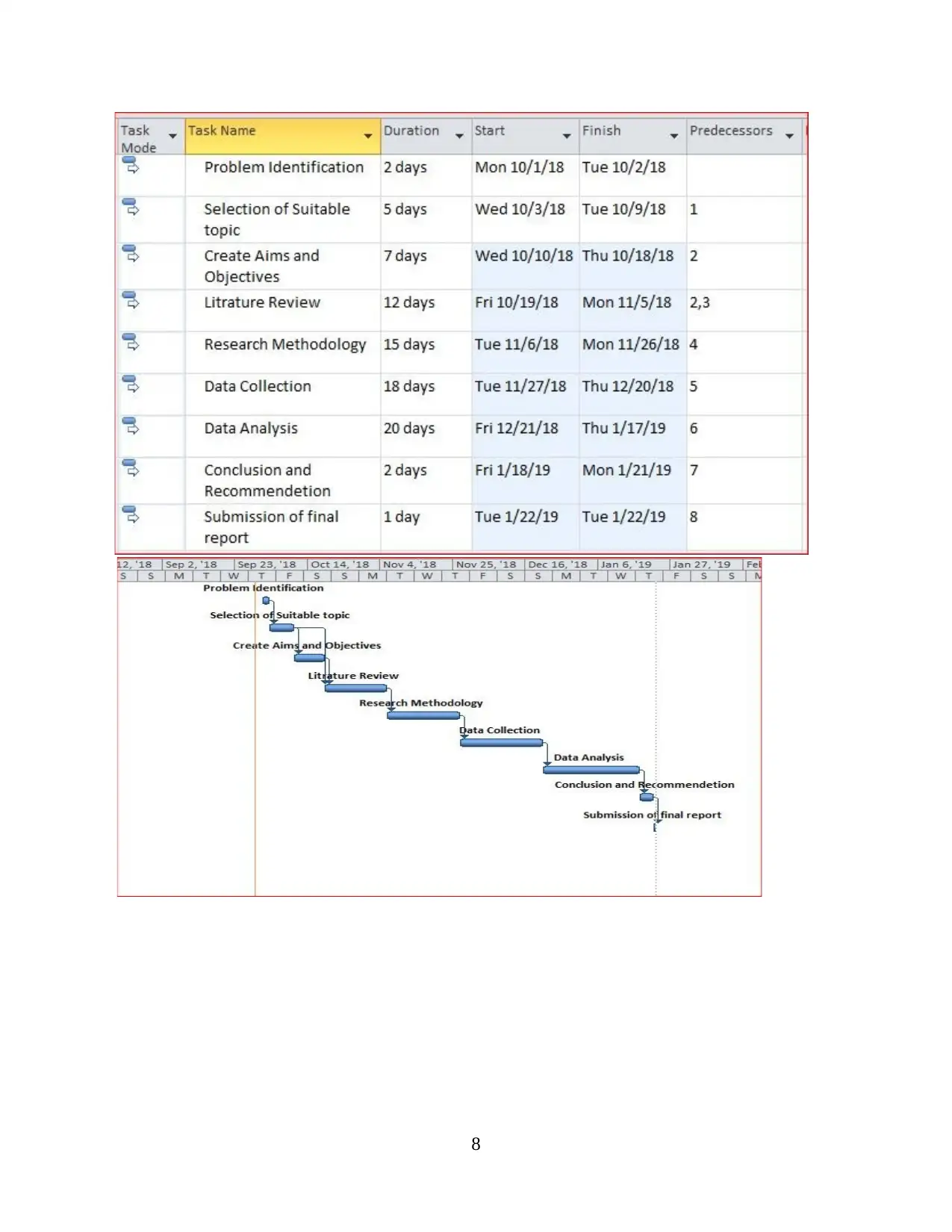
8
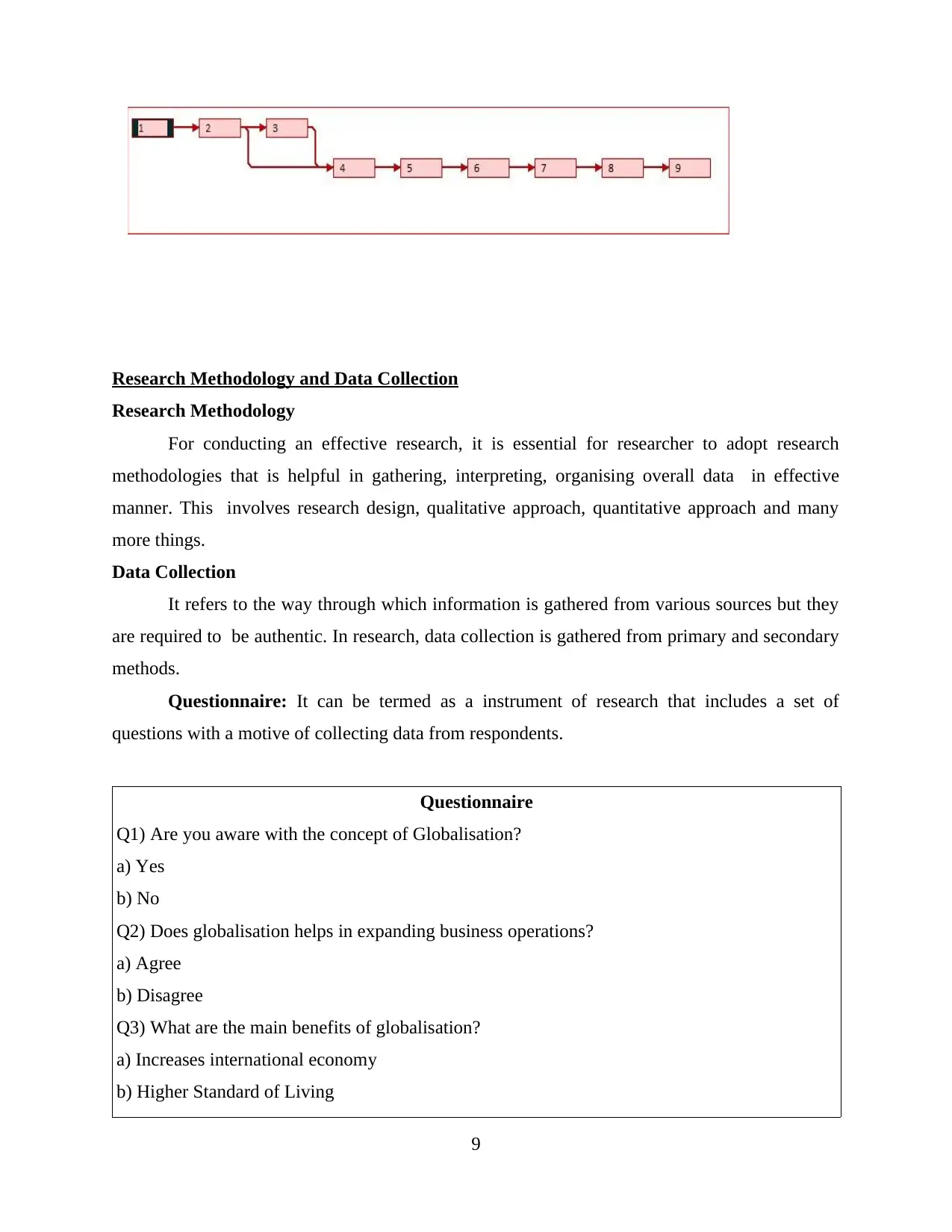
Research Methodology and Data Collection
Research Methodology
For conducting an effective research, it is essential for researcher to adopt research
methodologies that is helpful in gathering, interpreting, organising overall data in effective
manner. This involves research design, qualitative approach, quantitative approach and many
more things.
Data Collection
It refers to the way through which information is gathered from various sources but they
are required to be authentic. In research, data collection is gathered from primary and secondary
methods.
Questionnaire: It can be termed as a instrument of research that includes a set of
questions with a motive of collecting data from respondents.
Questionnaire
Q1) Are you aware with the concept of Globalisation?
a) Yes
b) No
Q2) Does globalisation helps in expanding business operations?
a) Agree
b) Disagree
Q3) What are the main benefits of globalisation?
a) Increases international economy
b) Higher Standard of Living
9
Research Methodology
For conducting an effective research, it is essential for researcher to adopt research
methodologies that is helpful in gathering, interpreting, organising overall data in effective
manner. This involves research design, qualitative approach, quantitative approach and many
more things.
Data Collection
It refers to the way through which information is gathered from various sources but they
are required to be authentic. In research, data collection is gathered from primary and secondary
methods.
Questionnaire: It can be termed as a instrument of research that includes a set of
questions with a motive of collecting data from respondents.
Questionnaire
Q1) Are you aware with the concept of Globalisation?
a) Yes
b) No
Q2) Does globalisation helps in expanding business operations?
a) Agree
b) Disagree
Q3) What are the main benefits of globalisation?
a) Increases international economy
b) Higher Standard of Living
9
⊘ This is a preview!⊘
Do you want full access?
Subscribe today to unlock all pages.

Trusted by 1+ million students worldwide
1 out of 29
Related Documents
Your All-in-One AI-Powered Toolkit for Academic Success.
+13062052269
info@desklib.com
Available 24*7 on WhatsApp / Email
![[object Object]](/_next/static/media/star-bottom.7253800d.svg)
Unlock your academic potential
Copyright © 2020–2025 A2Z Services. All Rights Reserved. Developed and managed by ZUCOL.





